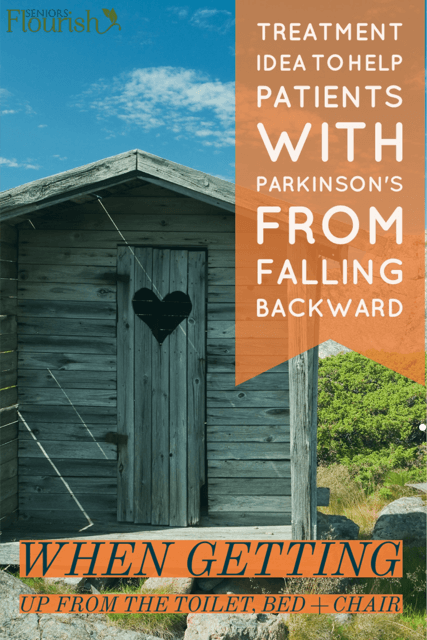Retropulsion has been a teensy-weensy thorn in my side.
As in, “I am not exactly sure how to train or what types of treatment ideas” are there for my patients with parkinsons disease (PD) pushing back or losing their balance backwards when I am specifically working on functional transfers.
It is a big factor in falls with my patients that have Parkinson’s Disease and limits transfer performance. Utilizing techniques from LSVT Big has been helpful, but I set out to figure out some new techniques for postural instability in PD (check out the video of a technique I came up with at the bottom of this article!).
So I did some research… Google searches… Pinterest… AOTA…
How do I make them more safe?
Besides adaptive equipment, can I even work on this effectively?
How can I instruct them to compensate for their limited ability to shift weight forward or maximize their strengths to accomplish this?
Besides verbal cuing of “nose over toes” with perfect body positioning, is there anything else I could try?
The only thing I could come up with and have tried is using a large ball to cue forward weight shift for sit to stands. Click here to see an article explaining the technique.
This technique does work great, but I have found that working in long term care, most of my patients are too advanced in their disease to be able to try this technique without the use of armrests or a stable surface to hold on to for safety.
But let’s start with the basics so you understand why this technique will be helpful for your patients with Parkinson’s disease.

What is Retropulsion?
Retropulsion is a characteristic symptom of Parkinson’s disease. It is a complex symptom that includes any of several motor symptoms that occur during the course of walking and gait.
It can be described as “the feeling that the feet are stuck to the floor” or “feeling like one is walking in glue.” It can also be described in terms of its effect on gait, “the feet feel heavy and may not respond to voluntary attempts to lift them;” this is referred to as “grip phenomenon”.
The feet do not move forward during normal walking but instead remain planted on the floor, causing the person to fall backwards; this is referred to as “freezing”.
This is common in people with Parkinson’s disease but it can also occur in other conditions such as multiple sclerosis, stroke and traumatic brain injury.
Try This Technique for Patients Who Fall Backwards When Transferring:
Video Transcript for the Retropulsion Intervention Idea
Mandy: Hi this is Mandy Chamberlain the occupational therapist with OT Flourish. I’m just going to show you a quick little technique that you can use with your patients that have Parkinson’s that perform retropulsion treatment during functional transfers.
End of transcript.
What techniques or exercise for retropulsion have you used to help treat your patients that have difficulty with functional transfers?
Are you looking for more information on treating patients with Parkinson’s Disease? We have a ton of resources in the OT Accelerator and here is a really good course from OccupationalTherapy.com called “A Practical Approach to Treating Individuals with Parkinson’s Disease.” Definitely worth a look.





